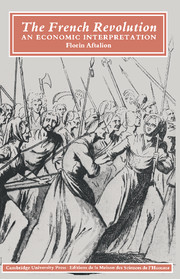Book contents
- Frontmatter
- Contents
- List of figures
- Chronology
- Acknowledgements
- Introduction
- 1 The fiscal crisis
- 2 The French economy at the end of the ‘Ancien Régime’
- 3 1789
- 4 The ‘assignats’
- 5 The finances of the Constituent Assembly
- 6 The rising cost of living, anarchy and war
- 7 The seizure of power by the Mountain
- 8 Economic dictatorship
- 9 ‘Dirigisme’ in retreat
- 10 The French Revolution: economic considerations
- Appendices
- Notes
- Select guide to further reading
- Index
7 - The seizure of power by the Mountain
Published online by Cambridge University Press: 05 June 2012
- Frontmatter
- Contents
- List of figures
- Chronology
- Acknowledgements
- Introduction
- 1 The fiscal crisis
- 2 The French economy at the end of the ‘Ancien Régime’
- 3 1789
- 4 The ‘assignats’
- 5 The finances of the Constituent Assembly
- 6 The rising cost of living, anarchy and war
- 7 The seizure of power by the Mountain
- 8 Economic dictatorship
- 9 ‘Dirigisme’ in retreat
- 10 The French Revolution: economic considerations
- Appendices
- Notes
- Select guide to further reading
- Index
Summary
The Convention met on 20 September, the same day as the Battle of Valmy was won. The tide of war seemed definitively to have turned a few weeks later, when success at Jemmapes (on 6 November) left Belgium in revolutionary hands. The Executive Council, together with a majority of the new Assembly, took advantage of this turn of events to consolidate their authority. But from this point on a remorseless struggle was waged between those who advocated a restoration of order and the leaders of the Commune and of the sections.
The trial of the King made plain just what contradictions and oppositions there were within the Convention itself. The Mountain, although in a minority, triumphed over the Girondins, who wished to restore order, and for the most part to save the neck of Louis XVI. It managed to eliminate its rivals once and for all during the insurrections of 31 May and 2 June 1793, when it made the rioters' demands its own. It paid a price, however, for allying with the sections, for certain of its most eminent representatives reneged upon their convictions regarding economics and accepted the principle of a Maximum for grain.
While those dramatic events which led from the fall of the monarchy to the seizure of power by the Mountain were unfolding, anarchy, and fiscal anarchy in particular, continued to prevail. In spite of a few lucid but isolated protests, the Convention proved no more capable than the earlier Assemblies had been of resolving its financial problems, except of course by recourse to assignat.
- Type
- Chapter
- Information
- The French RevolutionAn Economic Interpretation, pp. 119 - 137Publisher: Cambridge University PressPrint publication year: 1990



